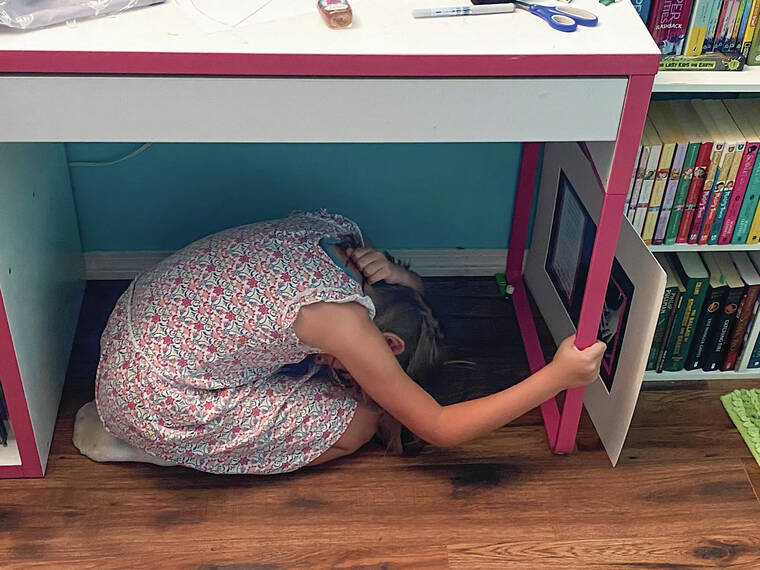The magnitude-6.2 earthquake that occurred on Sunday, Oct. 10 at 11:49 a.m. HST, originated just south of the island of Hawaii. The large earthquake, caused by bending of the oceanic plate, serves as a stark reminder that the State of Hawaii is no stranger to potentially damaging earthquakes.
From Niihau to Kilauea, all Hawaii residents live on landscapes shaped by volcanoes. Each Hawaiian volcano starts on the floor of the Pacific Ocean. Over time — and with countless eruptions — lava accumulates as the volcano grows above sea level, eventually creating the islands we now call home.
Beyond the inhabited islands are numerous other volcanic piles weighing down on the ocean bottom. To the southeast is Kamaʻehuakanaloa (formerly Loʻihi Seamount), a young submarine volcano that has yet to come up for air. Stretching far to the northwest, beyond Niihau to Mokupapapa (Kure Atoll), are mostly eroded volcanoes that make up the Papahanaumokuakea Marine National Monument.
To give a perspective of the immense mass sitting on the Pacific plate, the tallest of these volcanoes, Maunakea, is nearly a mile taller than Mount Everest from the base to the summit. The distance from Mokupapapa to Kamaʻehuakanaloa, is about 2,500 km (1,600 miles). With the addition of the Emperor Seamounts, which stretch even farther to the northwest, that length increases to 6,200 km (3,900 miles). That is a lot of lava, stacked far and tall.
Although infrequent, the broad and rigid oceanic plate bends and buckles under the immense weight of these islands. Earthquakes of this type can be compared to the creaks you might hear when walking on an old wooden lanai. The floor is merely reacting to the load placed upon it.
These types of earthquakes are typically deep and do not generate tsunamis. The water column needs to be displaced by a fault breaching the seafloor, not just shaken by an earthquake, for a tsunami to occur.
Some of the impacts from earthquakes, like the recent magnitude-6.2, can be minimized when we prepare in advance.
There are countless small actions we can do, long before another earthquake strikes, to protect ourselves, our ‘ohana, and our property. Make a plan and build a supply kit that can be used in case of an emergency. Fastening heavy objects like a bookcase or television to the wall will lessen the chances of them tipping over. Having sturdy latches on cupboards will help stop dishes from flying across the kitchen. These are just a couple of the small things we can do to prepare. Check out https://www.shakeout.org/hawaii to find out what else can be done.
The USGS Hawaiian Volcano Observatory, along with thousands of residents across the state, participate yearly in The Great Hawaii ShakeOut to raise awareness for earthquake preparedness.
International ShakeOut Day is the third Thursday of every October. The Thursday date also determines the time when we practice what to do during an earthquake. This year, on 10/21 at 10:21 a.m., we invite you to ‘Drop, Cover and Hold On’ with us.
Tag us (@USGSVolcanoes) on Twitter, Facebook, or Instagram and show us how Hawaii does ShakeOut. Because the last magnitude-6 earthquake will not be the last magnitude-6 earthquake.
Volcano activity updates
Kilauea volcano is erupting. Its USGS Volcano Alert level is at WATCH (https://www.usgs.gov/natural-hazards/volcano-hazards/about-alert-levels). Kilauea updates are issued daily.
Lava continues to erupt from a single vent in the western wall of Halemaʻumaʻu crater. All lava activity is confined within Halemaʻumaʻu crater in Hawaii Volcanoes National Park. Sulfur dioxide emission rates remain high and were estimated at around 4,400 tonnes per day on Oct. 13. Seismicity is elevated but stable, with few earthquakes and ongoing volcanic tremor. Summit tiltmeters continue to record slight inflationary tilt through this afternoon. For more information on the current eruption, see Recent Eruption (usgs.gov).
Mauna Loa is not erupting and remains at Volcano Alert Level ADVISORY. This alert level does not mean that an eruption is imminent or that progression to an eruption from the current level of unrest is certain. Mauna Loa updates are issued weekly.
This past week, about 84 small-magnitude earthquakes were recorded below the summit and upper elevation flanks of Mauna Loa — the majority of these occurred at shallow depths less than 8 kilometers (5 miles). Global Positioning System measurements show no major deformation over the past week. Gas concentrations and fumarole temperatures at both the summit and at Sulphur Cone on the Southwest Rift Zone remain stable. Webcams show no changes to the landscape. For more information on current monitoring of Mauna Loa, see: https://www.usgs.gov/volcanoes/mauna-loa/monitoring.
There were 11 events with 3 or more felt reports in the Hawaiian Islands during the past week. Listed here are the felt events with magnitudes of 3 and above: a M3.0 earthquake 3 km (1 mi) S of Pahala at 35 km (22 mi) depth on Oct. 12 at 6:35 a.m. HST, a M3.0 earthquake 6 km (3 mi) ENE of Pahala at 35 km (22 mi) depth on Oct. 10 at 10 p.m. HST, a M4.3 earthquake 22 km (13 mi) S of Naalehu at 35 km (22 mi) depth on Oct. 10 at 11:53 a.m. HST, a M6.2 earthquake 27 km (16 mi) SSE of Naalehu at 35 km (21 mi) depth on Oct. 10 at 11:48 a.m. HST, a M3.6 earthquake 7 km (4 mi) ENE of Pahala at 35 km (22 mi) depth on Oct. 9 at 1:08 p.m. HST, and a M3.5 earthquake 1 km (0 mi) S of Pahala at 34 km (21 mi) depth on Oct. 7 at 8:25 p.m. HST.
HVO continues to closely monitor Kilauea’s ongoing eruption and Mauna Loa for any signs of increased activity.
Please visit HVO’s website for past Volcano Watch articles, Kīlauea and Mauna Loa updates, volcano photos, maps, recent earthquake info, and more. Email questions to askHVO@usgs.gov.
Volcano Watch is a weekly article and activity update written by U.S. Geological Survey Hawaiian Volcano Observatory scientists and affiliates.



